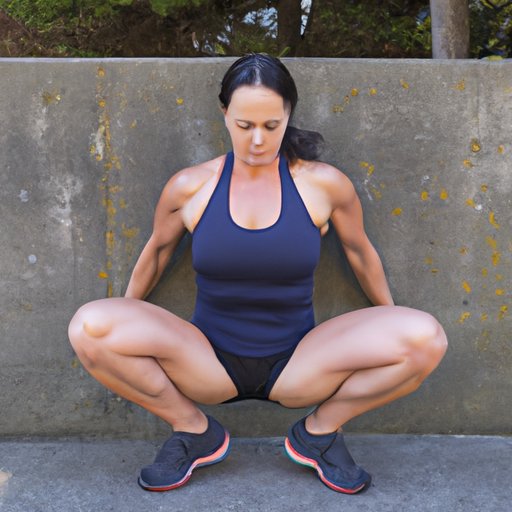
Introduction
If you want to improve your leg and core strength, then wall sits are the perfect workout for you. Also known as wall squats, this exercise is performed with your back against a wall and your legs at a 90-degree angle. Wall sits are a popular exercise that require no equipment, can be done at home or at the gym, and can help increase endurance, improve posture, and enhance balance. In this article, we’ll explore all things wall sits, breaking down the correct form, explaining the benefits, and providing tips for perfecting this exercise.
Breaking Down Wall Sits: The Ultimate Guide to Perfecting Your Form
The correct form is essential when it comes to wall sits. Here’s how you can ensure that you’re doing them the right way:
- Stand with your back against a wall and your feet shoulder-width apart.
- Slowly slide your back down the wall while maintaining contact with it until your thighs are parallel to the floor.
- Hold this position for a few moments before pushing back up to your starting position.
It’s important to avoid these common mistakes while doing wall sits:
- Letting your knees extend too far over your ankles.
- Arching your lower back.
- Dropping your hips too low.
To improve your form, try these tips:
- Align your knees with your ankles.
- Maintain a neutral spine.
- Engage your core throughout the exercise.
Wall Sits: An Essential Exercise for Legs and Core Strength
Wall sits are an excellent way to improve leg and core strength, and there are several reasons why they’re such a popular exercise:
- They work multiple muscle groups at once, including your quadriceps, hamstrings, calves, and core.
- They’re low impact, which makes them an ideal exercise for people of all fitness levels, including those with joint pain.
- They can increase endurance by building up the muscles you use for everyday activities, such as walking and standing.
In comparison to other leg and core exercises, wall sits are unique in that they allow you to use your own body weight as resistance. While squats and lunges are also beneficial for building strength, wall sits can help you focus more on endurance and stability.
Why You Should Add Wall Sits to Your Workout Routine
It’s important to incorporate wall sits into your workout routine because of their numerous benefits, which include:
- Improved muscular endurance.
- Increased core and leg strength.
- Better balance and posture.
- Prevention of injury by strengthening the muscles that support your joints.
By performing wall sits on a regular basis, you can experience these benefits and improve overall fitness.
Wall Sits vs. Squats: Which Is Better?
Although wall sits and squats may seem similar, there are significant differences between the two exercises:
- Wall sits are an isometric exercise, meaning that they target muscles by holding a static position, while squats are a dynamic exercise, involving movement up and down.
- Wall sits place more emphasis on endurance, while squats focus more on strength.
- Wall sits are easier on the knees and back, making them a more accessible exercise for those with knee and back pain.
Both wall sits and squats are great exercises that target the same muscle groups, but it’s important to choose the one that is best suited to your fitness level and goals.
How Long Should you Hold a Wall Sit?
How long you should hold a wall sit will depend on your fitness level and goals. Beginners should start with 30-second intervals and gradually work up to longer periods of time. More experienced individuals may be able to hold an isometric wall sit for up to two minutes.
To build strength and endurance, try these tips:
- Gradually increase the amount of time you hold the wall sit by 10-15 seconds each week.
- Alternate sets of longer wall sits with sets of shorter wall sits for a total of 2-3 minutes of exercise.
- Perform wall sits with weights to increase resistance and difficulty.
The Benefits of Wall Sits: How They Can Improve Your Posture and Balance
In addition to strengthening the muscles in your legs and core, wall sits can also help improve your posture and balance. By holding a static position, you force your body to engage the muscles that support your spine and back. This, in turn, can lead to better posture and balance overall.
Research has also shown that wall sits can help reduce the risk of falls among older adults, as well as improve the balance of those with conditions such as multiple sclerosis.
The Do’s and Don’ts of Wall Sits: Tips for Avoiding Common Mistakes
To get the most out of your wall sit workout, here are some common mistakes to avoid:
- Don’t let your knees extend too far over your toes during the exercise, as this can put a strain on your knees and cause injury.
- Don’t arch your back, as this puts stress on the lower back and can lead to injury.
- Don’t hold your breath. Breathe normally throughout the exercise in order to maintain proper form and avoid dizziness.
To maximize the benefits of wall sits, try these tips:
- Do engage your core throughout the exercise.
- Do maintain good posture throughout the exercise.
- Do keep your knees aligned with your ankles to avoid injury.
Conclusion
Wall sits are an excellent exercise for building core and leg strength, improving endurance, enhancing balance, and promoting better posture. Make sure to use proper form, avoid common mistakes, and gradually increase the amount of time you hold the wall sit to reap all the benefits this exercise has to offer.




